Fort Smith, Arkansas 作者: 来源: 发布时间:2021-07-19
I.Population and Area
₋Area
Land: 63.99 sq mi (165.74 km2)
₋Population
Total: 87,891
Density: 1,373.45/sq mi (530.29/km2)
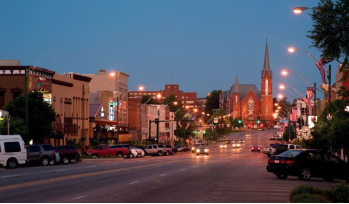
II.Natural Geography
₋Fort Smith is the second-largest city in Arkansas and one of the two county seats of Sebastian County. As of the 2010 Census, the population was 86,209. With an estimated population of 87,891in 2019, it is the princip al city of the Fort Smith, Arkansas-Oklahoma Metropolitan Statistical Area, a region of 298,592 residents that encompasses the Arkansas counties of Crawford, Franklin, and Sebastian, and the Oklahoma counties of Le Flore and Sequoyah.
₋Fort Smith has a sister city relationship with Cisterna, Italy, site of the World War II Battle of Cisterna, fought by United States Army Rangers commanded by Fort Smith native William O. Darby. The city also has a mutual friendship-city relationship with Jining, China.
₋Fort Smith lies on the Arkansas-Oklahoma state border, situated at the confluence of the Arkansas and Poteau rivers, also known as Belle Point. Fort Smith was established as a western frontier military post in 1817, when it was also a center of fur trading. The city developed there. It became well known as a base for migrants' settling of the "Wild West" and for its law enforcement heritage.
₋In 2007, the city of Fort Smith was selected as the site of the new United States Marshals Service National Museum, slated to open in 2019.
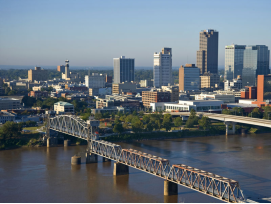
III.GDP
₋The average salary in Fort Smith, AR is $14.59. Trends in wages decreased by -100.0 percent in Q1 2020. The cost of living in Fort Smith, AR is 100 percent higher than the national average. The most popular occupations in Fort Smith, AR are Certified Nurse Assistant (CNA), Licensed Practical Nurse (LPN), and Registered Nurse (RN) which pay between $9.69 and $25.32 per year. The most popular employers in Fort Smith, AR are Mercy Hospital, Sparks Hospital, and OK Foods Inc..
₋Website: https://www.payscale.com/research/US/Location=Fort-Smith-AR/Salary
IV.Industrial Characteristics
₋Manufacturing is the heart and soul of Fort Smith, with more than 30,000 residents employed in the manufacturing field. In fact, some of the city’s largest employers are manufacturing companies, including Whirlpool Corporation with 3,000 employees, Rheem Air Conditioning with 1,774 employees and Gerber Products with 761 employees. Of the 300,000 residents in the Greater Fort Smith Region, nearly 30 percent work for a manufacturing company compared to only 13 percent in the national sector.
₋Baldor Electric Company houses its corporate headquarters in Fort Smith and employs more than 2,250 people in the region. Baldor produces Baldor, Dodge and Reliance motors and boasts more than three plants in the Greater Fort Smith Region in Fort Smith, Ozark and Clarksville. Employing more than 8,000 in 50 district sales offices across the United States and Canada, Baldor products are sold in more than 70 countries worldwide with 26 international sales offices located in Europe, the Middle East, Latin America and Australia. In 2007, Baldor acquired Reliance Electric, more than doubling the size of the company. Sales ended that same year at $1.82 billion – more than double the year before – while earnings increased to $94.1 million – nearly double than the year before.
₋Fort Smith is also home to major food manufacturers including O.K. Industries, one of the world’s largest chicken producers and employing more than 5,000 in the Greater Fort Smith Region. O.K. Industries offers a full line of quality chicken products and services a broad customer base of independent restaurants, food service distributors, national chain restaurants, grocery retailers and other food manufacturers. O.K. Industries produces the nationally known TenderBird frozen chicken line found in your local grocery store, as well as chicken nuggets, strips and patties provided to national food chains in hometowns across America.
₋Website: https://local.townsquarepublications.com/arkansas/fortsmith/08/topic.html
V.Attractions
1.Fort Smith National Historic Site
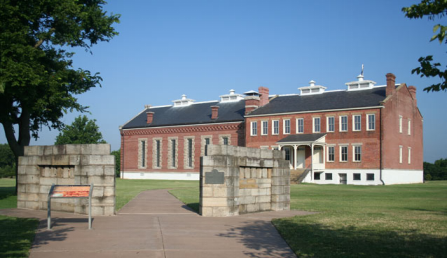
₋Fort Smith National Historic Site is a National Historic Site located in Fort Smith, Arkansas, along the Arkansas River. The first fort at this site was established by the United States in 1817, before this area was established as part of Indian Territory. It was later replaced and the second fort was operated by the US until 1871. This site was designated as a National Historic Landmark in 1961.
₋The fort was the first site of the United States District Court for the Western District of Arkansas, which had jurisdiction over western Arkansas and all of Indian Territory. It began operations in 1875 with the appointment of Isaac C. Parker as the first federal district judge here. The town of Fort Smith, Arkansas developed around the fort.
₋The site includes the second historic fort constructed at this place. In addition, located on the grounds are the foundation remains of the first Fort Smith (1817–1824), the commissary building (c. 1838) and a reconstruction of the gallows used by the federal court. A walking trail along the Arkansas River includes wayside exhibits on the Trail of Tears.
₋Congress authorized acquisition of land on the Oklahoma bank of the Arkansas River to be included in the National Historic Site, in order to preserve a historic viewshed, but it has not been acquired.
₋The park visitor center is now located in the old Barracks/Courthouse/Jail building. Exhibits in the visitor center focus on Fort Smith's military history from 1817–1871, its role in the western expansion of the United States, Federal District Judge Isaac Parker and the federal court's effects on justice in Indian Territory, the U.S. Deputy Marshals and outlaws, Federal Indian policy, and Indian Removal, including the Cherokee Trail of Tears.
₋Address: 301 Parker Ave, Fort Smith, AR 72901, United States
₋Website: https://www.nps.gov/fosm/index.htm
2.Fort Smith Trolley Museum
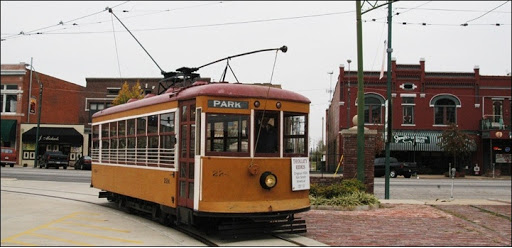
₋The Fort Smith Trolley Museum is a streetcar and railroad museum in Fort Smith, in the U.S. state of Arkansas, which includes an operating heritage streetcar line. The museum opened in 1985, and operation of its streetcar line began in 1991. Four vehicles in its collection, a streetcar and three steam locomotives, are listed on the National Register of Historic Places (NRHP). The now approximately three-quarters-mile-long (1.2 km) streetcar line also passes four NRHP-listed sites, including the Fort Smith National Historic Site, the Fort Smith National Cemetery, the West Garrison Avenue Historic District and the 1907 Atkinson-Williams Warehouse Building, which now houses the Fort Smith Museum of History.
₋The museum was established by the Fort Smith Streetcar Restoration Association (FSSRA), formed in 1979 to preserve and display transit history relating to Fort Smith. The first museum building was constructed in 1985, on former Missouri Pacific Railroad land, and purchases and donations of property in the 1990s allowed activities and storage to expand onto adjacent parcels. That the organization uses Streetcar in its name but named its museum a Trolley museum is a reflection of the fact that, in American English, the terms streetcar and trolley are used interchangeably. The Fort Smith Trolley Museum (FSTM) opened to the public in 1985, and trolley/streetcar operation began in 1991. FSSRA continues to be the museum's owner and operator.
₋Address: 100 S 4th St, Fort Smith, AR 72901, United States
₋Phone: +1 479-783-0205
₋Website: https://www.fstm.org/
3.Clayton House
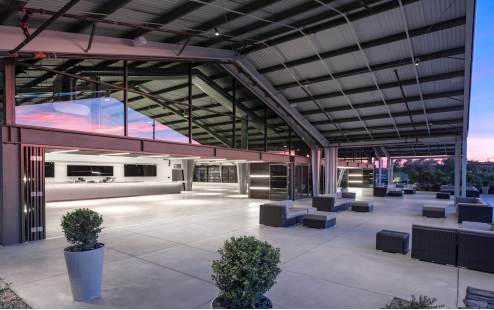
₋The W.H.H. Clayton House, now the Clayton House Museum, is a historic house museum at 514 North 6th Street in Fort Smith, Arkansas. It is a 2-1/2 story L-shaped wood frame structure, with a projecting front clipped-gable section. It has elaborate Victorian trim, including detailed window surrounds, paneled projecting bays on the front and side, and a porch with carved columns and brackets, and delicately turned balusters ringing the porch roof. The house was built in 1882 for W. H. H. Clayton, who served as a local prosecutor and was member of family prominent in state politics, and is one of the few high-quality houses of the period to survive. It is now a museum.
₋The house was the home of W.H.H. Clayton, United States Attorney for the United States District Court for the Western District of Arkansas and chief prosecutor in the court of "hanging judge" Isaac Parker.
₋The house was listed on the National Register of Historic Places in 1970.
₋Address: 514 N 6th St, Fort Smith, AR 72901, United States
₋Opened: 1882
₋Phone: +1 479-783-3000
₋Website: http://claytonhouse.org/
VI.History
₋This area was occupied for thousands of years by indigenous peoples, attracted to the advantageous site near the rivers. They used the waterways for transportation and trading, and to supply fish and water for their villages. The French claimed this area as part of their New France and La Louisiana. Some colonial fur traders traveled the Arkansas and other rivers to trade with the native American tribes.
₋The United States acquired this territory and large areas west of the Mississippi River from France in the Louisiana Purchase (1803). Soon after, the government sent the Pike Expedition (1806) to explore the areas along the Arkansas River. The US founded Fort Smith in 1817 as a military post. It was named after General Thomas Adams Smith (1781–1844), who commanded the United States Army Rifle Regiment in 1817, headquartered near St. Louis. General Smith had ordered Army topographical engineer Stephen H. Long (1784–1864) to find a suitable site on the Arkansas River for a fort. General Smith never visited this town or the forts that bore his name.
₋A stockade was built and occupied from 1817 until 1822 by a small troop of regulars commanded by Major William Bradford. A small settlement began forming around the fort, but the Army abandoned the first Fort Smith in 1824 and moved 80 miles further west to Fort Gibson. John Rogers, an Army sutler and land speculator, bought up former government-owned lands at this site and promoted growth of the new civilian town of Fort Smith.
₋Due to the strategic location of this site, the federal government re-established a military presence at Fort Smith during the 1830s era of Indian Removal, primarily of tribes from the American Southeast to west of the Mississippi River in Indian Territory, which is now Oklahoma.
₋In 1838 the Army moved back into the old military post near Belle Point, and expanded the base. They used troops to escort Choctaw and Cherokee, from their ancestral homelands in the Southeast; they were the last of the tribes to leave. Remnants of the Five Civilized Tribes remained in the southeast, and their descendants in some cases have reorganized and been federally recognized. The Cherokee called the forced march the Trail of Tears, as many of their people and African-American slaves died along the way. The army enforced the removal of these peoples to the reserved Indian Territory, where the federal government granted them land. Many displaced Native Americans fell out of the march and settled in Fort Smith and adjoining Van Buren, Arkansas on the other side of the river.
₋The US Army also used Fort Smith as a base during the Mexican War (1846-1848). As a result, the US acquired large territories in the Southwest, and later annexed the Republic of Texas, which had been independent for some years.
₋Sebastian County was formed in 1851, separated from Crawford County north of the Arkansas River. In 1858, Fort Smith was designated as a Division Center of the Butterfield Overland Mail's 7th Division route across Indian Territory from Fort Smith to Texas and as a junction with the mail route from Memphis, Tennessee, an important port on the east side of the Mississippi River.
₋During the early years of the U.S. Civil War, the fort was occupied by the Confederate Army. Union troops under General Steele took control of Fort Smith on September 1, 1863. A small fight occurred there on July 31, 1864, but the Union army maintained command in the area until the war ended in 1865. As a result, many refugee slaves, orphans, Southern Unionists, and others came here to escape the guerrilla warfare raging in Arkansas, Missouri, and the Border States. The slaves were freed under the Emancipation Proclamation of January 1863 by President Abraham Lincoln. Federal troops abandoned the post of Fort Smith for the last time in 1871. The town continued to thrive despite the absence of federal troops.
₋Two of Fort Smith's most notable historic figures were Judge Isaac Parker and William Henry Harrison Clayton, also known as W.H.H. Clayton. In 1874, William Henry Harrison Clayton was appointed United States Attorney for the Western District of Arkansas by President Ulysses S. Grant. Fort Smith was a bustling community full of brothels, saloons and outlaws, just across the river from Indian Territory. William Clayton realized a strong judge would be necessary to bring law and order to the region. He knew that Isaac Parker was a strong judge. But Judge Parker had been appointed Chief Justice of Utah Territory and confirmed by the US Senate. With the help of President Grant and US Senator Powell Clayton, former governor of Arkansas, William Clayton was able to gain the appointment of Judge Parker in the Fort Smith district.
₋Judge Isaac Parker served as U.S. District Judge 1875–1896. He was nicknamed the "Hanging Judge": in his first term after assuming his post, he tried 18 people for murder, convicted 15 of them, and sentenced eight of those to die. Six of these men were later hanged on the same day. Over the course of his career in Fort Smith, Parker sentenced 160 people to death. Of those, 79 were executed on the gallows. His courthouse is now marked as a National Historic Site, where "more men were put to death by the U.S. Government... than in any other place in American history."
₋William Clayton served as US Attorney under four different presidents and later was appointed as Chief Justice of Indian Territory. He was instrumental in achieving statehood for Oklahoma in 1907, after Native American claims were extinguished by distribution of communal lands under the Dawes Act and the breakup of tribal governments. Together with Territorial Governor Frank Frantz, Clayton took a copy of the Oklahoma Constitution to President Theodore Roosevelt after the state was admitted to the Union in 1907. Governor Frantz and Judge Clayton both lost their territorial positions when Oklahoma became a state; a new governor was elected and the Roosevelt administration appointed a new judge.
₋During investment in the military prior to World War II, the Army returned to Fort Smith in 1941. It established the Fort Chaffee Military Reservation east of the city.
₋On April 21, 1996, a large tornado, part of the April 1996 Tornado Outbreak Sequence, destroyed and heavily damaged much of historic downtown Fort Smith around the Garrison Avenue Bridge. The storm tracked from eastern Pittsburg County, Oklahoma into Fort Smith and Van Buren, Arkansas. The tornado left four people dead in western Arkansas. Days later, the damaged Eads Brothers Furniture building in downtown Fort Smith was destroyed by one of the largest fires in the city's history.
VII.Other Information
₋Education
₋Higher education
₋The city has one major university that is part of the University of Arkansas System. The University of Arkansas at Fort Smith was founded in 1928 as an extension of the Fort Smith Public School system, with the superintendent, James William Ramsey, acting as the college president and the high school principal as dean. Known originally as Fort Smith Junior College, the institution operated within the Fort Smith public school system until 1950, when the school was incorporated as a private, nonprofit institution with its own governing board. In September 1952, the College moved from borrowed facilities in the high school to its current site, initially occupying 15 acres (6.07 ha).
₋In 1966, the institution's name was changed from Fort Smith Junior College to Westark Junior College and in 1972, it was renamed Westark Community College, indicating the larger area to be served and reflecting the more comprehensive mission.
₋The name of the college was changed yet again in February 1998 to Westark College, more accurately portraying the role and scope of the institution.
₋On December 15, 2000, the Board of Trustees of Westark College entered into an agreement with the Board of Trustees of the University of Arkansas to merge with the University of Arkansas System as a four-year institution. In 2001, the Sebastian County electorate voted to support the merger. A formal request to change affiliation status to that of a bachelor's degree-granting institution under the name of the University of Arkansas at Fort Smith was submitted to the Higher Learning Commission in August 2001 and approved by the Institutional Actions Council on November 19, 2001.
₋The merger, which became official on January 1, 2002, endorsed the concept of UA-Fort Smith as a unique university, one that offers applied and traditional baccalaureate degree programs, one- and two-year associate and technical programs, and noncredit business and industry training programs. While the University of Arkansas at Fort Smith is the city's only state supported institution of higher learning, Webster University and John Brown University each have a satellite campus located in the city.
₋In addition to the University of Arkansas-Fort Smith (UAFS), the Arkansas College of Osteopathic Medicine (ARCOM), a private, non-profit institution, welcomed its inaugural class in August 2017. Graduates of ARCOM receive a Doctor of Osteopathic Medicine (DO) degree.
₋Elementary and secondary education
₋The public schools in Fort Smith and Barling are operated by the Fort Smith School District. Currently, the district includes 26 schools. As of the 2009–2010 school year, the district has enrollment of more than 14,010. It has 2 high schools, 4 junior high schools, 19 elementary schools, and 1 alternative learning center. Fort Smith public schools provide education from kindergarten through the 12th grade, as do some private Protestant schools. Catholic parochial schools offer education through the ninth grade.
₋Junior high schools in Fort Smith include Chaffin Junior High School, Ramsey Junior High School, Kimmons Junior High School and Darby Junior High School. Private schools covering the same grade range include Trinity Catholic Junior High School and Union Christian Academy.
₋High schools in Fort Smith include the public Northside High School and Southside High School, along with the private Union Christian Academy.
₋Fort Smith previously had a Catholic grade school for black children, St. John the Baptist School; it closed in 1968.
VIII.Contact Information
₋Government
Mayor: George McGill (D)
₋City Hall
₋Address:
623 Garrison Ave.
Room 303
Fort Smith, AR 72901
₋Phone: 479-784-2208
₋Fax: 479-784-2256
₋Email: cityclerk@fortsmithar.gov
